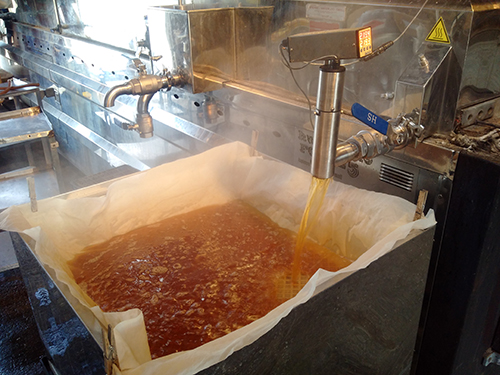How Did We Get Here?
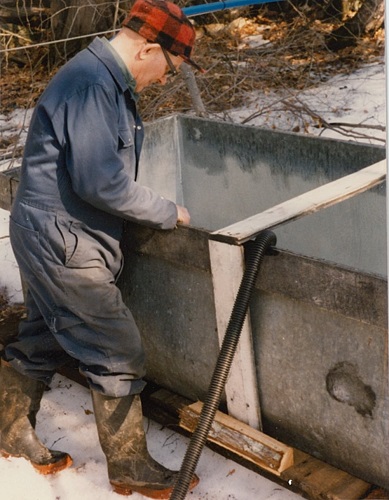
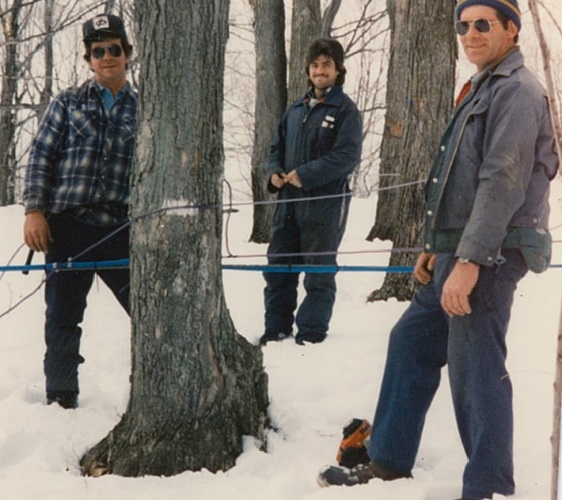
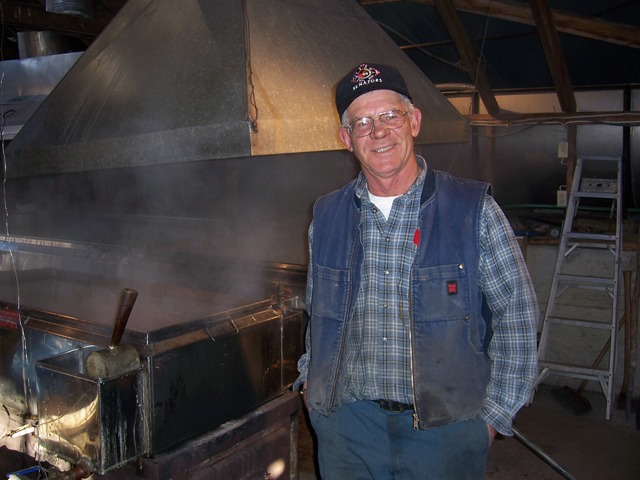
- Arthur Ennis (b. 1792) immigrated from County Cavan, Ulster, Ireland to Lanark County in Upper Canada in 1840. Arthur and his brother James Ennis were responsible for establishing several mills in Drummond and Bathurst Townships.
- Arthur (b. 1837) and Rebecca Ennis (Marty & Andy’s great great grandparents) moved back to Ireland for a short time before returning to the family farm on Bennett Lake in 1868.
- Their son James Arthur Ennis (b. 1882) married Margaret Buffam and they bought more land on the lake through the early part of the 20th century.
- Hubert James Ennis (b. 1915) married Jean Graham after returning from WWII and they had five children – the oldest being George Arthur Ennis (b. 1950).
- George married Karen Stead and they had two boys (Martin and Andrew) and in the mid 1970’s they built a house on the family farm that Karen still lives in today.
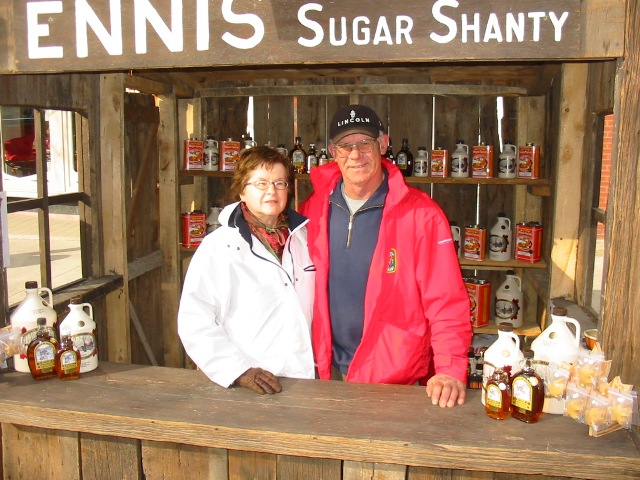


Our family has been making maple syrup on Ennis Road for almost a century and some of our trees have been tapped by four or five generations of the Ennis clan! Talk about sustainable farming!!! Sadly, our patriarch George Ennis passed away in August 2008 at the very young age of 58. Sons Marty and Andy along with their young families and mother Karen are carrying on the family tradition. On most late winter and early spring weekends three generations of Ennis’ work together to tap, gather and boil the sap. George & Karen’s grandchildren – Jessica, Aiden and Brandon – eagerly look forward to helping out in the sugar bush. They slog through deep snow to help tap trees, gather sap and pile firewood to feed the evaporator and to help bottle and label syrup. For the Ennis clan, family time in the spring is sugar making time!
Our sugar bush is located on the eastern shores of Bennett Lake at the end of Ennis Road in Lanark County – the Maple Syrup Capital of Ontario! Most of our sugar bush is located on what was called the North Farm because it was originally settled by William North in 1848 upon his arrival from County Cavan, Ireland.
Pre-1975
The original evaporator was located well back in the bush and the remnants of the old stone arch are still evident. The next evaporator was in a small shed nestled into the side of “Old Camp Hill” much closer to the road. Up to 1,100 taps on buckets fed the old evaporator. It had no running water and no electricity and was in use until 1975. So what did Hubert Ennis do when it got dark in his sugar shack in the woods? He went home, of course! The sap would still be there waiting for him in the morning.
1976
The new sugar camp was built in 1976 to house the Waterloo Small 5’x16’ wood fired arch. The 5’x16′ evaporator devoured firewood for 35 years until it was replaced in 2010. The sugar camp is still in use today – with some minor structural and mechanical changes along the way! The larger evaporator allowed for more trees to be tapped. In the late 1970’s gravity tubing was installed along hillsides that had not previously been tapped to allow more sap to be collected with less effort.
1980’s
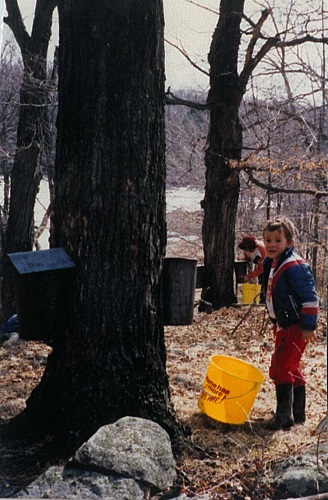
Vacuum was added to the tubing in the main bush in the early 1980s. Gradually, the tubing was expanded to four different collection systems by the early 1990s. The last of these bushes were put on the vacuum in 2004. Significant increases in sap volumes were seen with each successive bush that was put on a vacuum system.
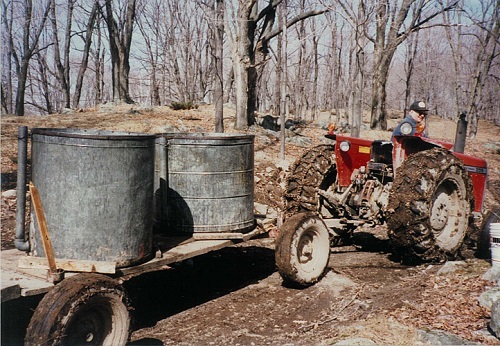
The Ice Storm of 1998
Prior to the Ice Storm we had approximately 4,000 taps on a combination of vacuum and gravity tubing. The Ice Storm destroyed much of our sugar bush and we were assessed at 56% crown loss. Many of the 24“+ trees that had been tapped for most of the 20th Century were snapped like toothpicks or stripped bare of limbs and branches. All our tubing was dropped to the ground and encased in a blanket of ice and snow. For the first time in memory no maple syrup was produced on the Ennis Farm.
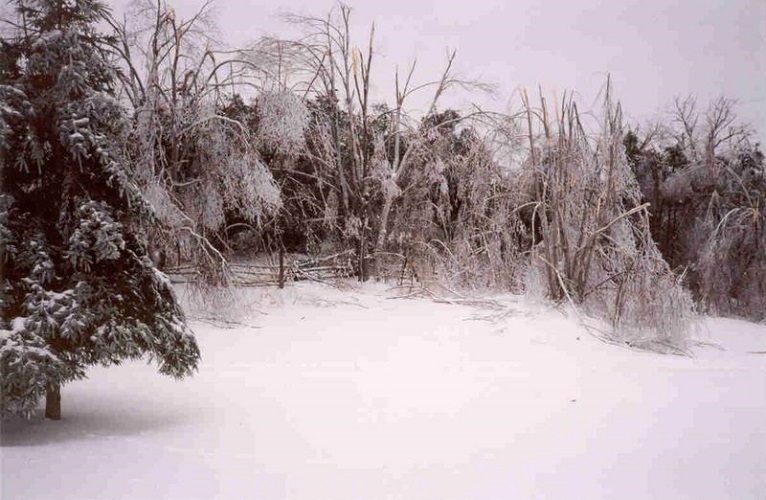
1999

Foresters were brought in to help clean up the bush and remove widow-makers. By the spring of 1999 we had repaired lines and cleaned up enough of the damage to make 38 gallons of maple syrup – less than 10% of our pre-Ice Storm production. Over the ensuing years the remainder of the woods was cleaned up, tubing was repaired and vacuum was added to all the tubing systems to increase the amount of sap collected. George Ennis was determined to make the sugar bush bigger and better than ever!
2003
With the new vacuum system extremely long days boiling on the wood fired arch became the norm. Something had to be done to reduce the labour and fuel put into boiling the sap into syrup so a 600 GPH reverse osmosis machine was purchased. The extra boiling capacity the R.O. offered meant further expansion was possible. New taps were added as young trees matured and several sap ladders were constructed to allow trees situated well below the mainline to be tapped.
2007 - 2008
After the Ice Storm our New Bush was slowly thinned to promote the young maples. In late 2007 and through the winter of 2008 a building was constructed for 2 open top tanks and a double vertical releaser. A dryline was run 2,000 feet from a new flood oil vacuum pump set up at the nearest power source. Mainlines were laid out and constructed and 900 new taps were added to bring the total to over 4,000 taps again. More taps are readily available in the New Bush and will be added as time permits.
New for 2010 – Our 3.5′ x 14′ Lapierre Hurricane Force 5 Evaporator!!!
Our Force 5 evaporator is a brand new technology that was developed by Lapierre Waterloo Small and ours was the first installed in Ontario! It is wood-fired with forced air and greater than 85% efficient – comparable to a propane or natural gas evaporator. This high efficiency means that almost all of the BTU’s from the wood get transferred into the pans to boil the sap into syrup. It is so efficient that we understand it is the only evaporator eligible for the Government of Ontario’s Environmental Farm Plan funding.
Why wood fired? Simple – It grows on trees! To us, it makes more sense to burn something that grows naturally on our property than to burn fossil fuels that have been extracted from the ground far away and shipped to us. That takes far more energy than the energy it takes us to cut, split and stack firewood. Efficient wood burning stoves (and evaporators!) have been argued to be carbon neutral as the wood we burn for heat is simply releasing the carbon that the tree absorbed over its lifetime. This carbon was in our atmosphere over the past decades and will be re-absorbed by the remaining trees that will rapidly grow to fill in the hole in the canopy left by the tree that was cut. If you want to know more about Lapierre Hurricane Force 5 Evaporator watch the video on YouTube.
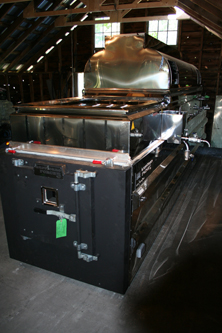
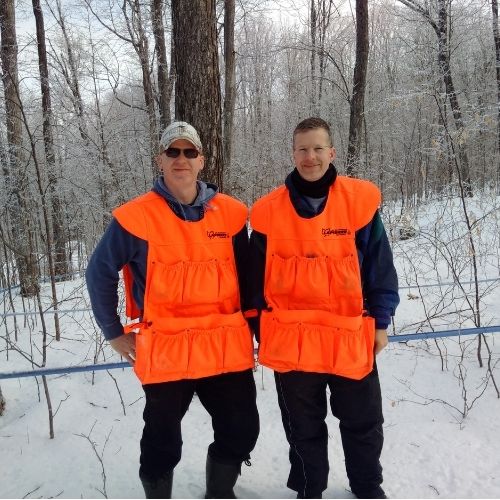
2011 - 2012
Marty and Andy continued to put more time and effort into improving the productivity of the sugar bush. A Food Safety and Traceability initiative has been completed which meant replacing much of the old equipment. An Environmental Farm Plan has also been prepared which helps guide us towards being better stewards of the land. Never satisfied with the status quo, we have constructed several new sap buildings that house large stainless steel tanks to hold sap. More trees have been tapped; New taps that produce more sap per tap have replaced the old spiles; Almost 400 taps (10%) were removed from the woods on trees that had too many taps each, and; All the old tubing and mainlines have been replaced. These improvements will allow us to make more high quality syrup per tap while having less impact on the long-term health of the trees.
2013 - 2015
We continued to make improvements to get more productivity out of our woods. Over 900 new taps were brought online in our New Bush. The new tubing and previously untapped trees meant there was a lot more sap to process!
2016 - 2019
Having found ‘the sweet spot’ for the number of trees being tapped, Andy & Marty focused on getting more production out of the woods. Old tubing was replaced, mainlines were re-routed and the old dairy pumps were replaced with new high vacuum pumps that auto-start and stop based on the temperature. A remote monitoring system was purchased and installed to allow real-time troubleshooting of vacuum leaks in the woods. These improvements drastically increased the volume of sap being collected – meaning the ability of the RO and evaporator to process sap was now the most time-consuming activity on a daily basis.


2020
In order to process sap faster, a larger Reverse Osmosis machine was purchased and installed in the sugar camp. The new CDL RO has 3 membrane towers and was able to process over 1000 gallons of sap per hour and could concentrate sap to almost 20 Brix. The first few days we boiled using the new RO we had so much syrup running off per hour that we needed to shut the evaporator down to allow us to get the syrup filtered! Adjustments were made to our filtering procedures and what was once a very long day in the sugar camp could now be completed in half the time. COVID-19 hit in the middle of the sugaring season.
2021 - Thinking Ahead
With the drastic increases in sap being produced in the woods, gathering the sap with the tractor and wagon was the most time consuming activity. We have invested in 2x high pressure pumps and 4,000 feet of 1.5” tubing to pump the sap back from the New Bush and Main Bush directly to the sugar camp. We estimate this will save Bud 75 hours of gathering time on the tractor per season! This further reduces our carbon footprint.
